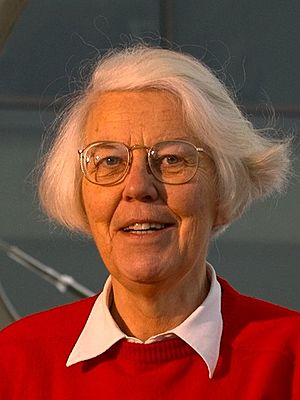Karen Spärck Jones facts for kids
Quick facts for kids
Karen Spärck Jones
|
|
|---|---|

Karen Spärck Jones in 2002
|
|
| Born | 26 August 1935 Huddersfield, Yorkshire
|
| Died | 4 April 2007 (aged 71) Willingham, Cambridgeshire
|
| Nationality | British |
| Alma mater | University of Cambridge |
| Known for | Term frequency–inverse document frequency |
| Spouse(s) | |
| Awards |
|
| Scientific career | |
| Fields | Computer science Information retrieval Natural language processing Document retrieval |
| Institutions | University of Cambridge |
| Thesis | Synonymy and Semantic Classification (1964) |
| Doctoral advisor | Richard Braithwaite |
Karen Spärck Jones (born August 26, 1935 – died April 4, 2007) was a very important British computer scientist. She came up with a big idea called inverse document frequency (IDF). This idea is super important for how almost all modern search engines work today!
In 2019, The New York Times newspaper wrote about her in a special series. They called her a "pioneer of computer science." This means she was one of the first people to do important work in the field. She combined statistics (working with numbers) and linguistics (the study of language). Karen also worked hard to support other women in computer science.
To honor her amazing work, the Karen Spärck Jones Award was created in 2008. This award is given to researchers who do great work in information retrieval (finding information) or natural language processing (teaching computers to understand human language).
Contents
Early Life and Education
Karen Ida Boalth Spärck Jones was born in Huddersfield, a town in Yorkshire, England. She went to a grammar school in Huddersfield.
From 1953 to 1956, she studied at Girton College, Cambridge. She first studied history, and then spent an extra year studying philosophy. For a short time, she worked as a school teacher. After that, she decided to move into the world of computer science.
Career in Computer Science
Karen Spärck Jones started working at the Cambridge Language Research Unit in the late 1950s. Later, in 1974, she moved to the Cambridge University Computer Laboratory. She worked there until she retired in 2002. From 1999, she held the important job of Professor of Computers and Information. Even after retiring, she kept working at the Computer Laboratory almost until she passed away. She wrote many books and papers about her research.
Her main research interests were natural language processing and information retrieval. These are about teaching computers to understand human language and helping them find information.
One of her most important ideas was the concept of inverse document frequency (IDF). She wrote about this idea in a paper in 1972. IDF helps search engines figure out how important a word is in a document. Today, IDF is used in most search engines. It's often part of a bigger system called term frequency–inverse document frequency (TF–IDF).
Awards and Honors
Karen Spärck Jones received many awards and honors for her groundbreaking work. An annual Karen Spärck Jones Award and lecture are named after her. This award celebrates new research in her fields.
In August 2017, the University of Huddersfield renamed one of its buildings after her. This building, now called the Spärck Jones building, is where the University's School of Computing and Engineering is located.
Some of her other important awards and honors include:
- She became a Fellow of the British Academy. This is a very high honor for experts in humanities and social sciences. She was also a Vice-President there from 2000 to 2002.
- She was elected a Fellow of the Association for the Advancement of Artificial Intelligence (AAAI) in 1993.
- She was also a Fellow of the European Association for Artificial Intelligence (ECCAI).
- She was the President of the Association for Computational Linguistics (ACL) in 1994.
- She won the Gerard Salton Award in 1988.
- She received the Association for Information Science and Technology (ASIS&T) Award of Merit in 2002.
- The Association for Computational Linguistics (ACL) gave her a Lifetime Achievement Award in 2004.
- She received the BCS Lovelace Medal in 2007.
- She won the ACM - AAAI Allen Newell Award in 2006.
- The Association for Computing Machinery (ACM) Women's Group gave her the Athena Award in 2007.
Personal Life
Karen Spärck Jones married another computer scientist from Cambridge, Roger Needham, in 1958.
See also
 In Spanish: Karen Spärck Jones para niños
In Spanish: Karen Spärck Jones para niños

